While the world is struggling to fight the COVID-19 pandemic, Extension and Advisory Services (EAS) have been innovative in using ICTs to support farmers. In this blog, Dr Sheikh N Meera illustrates these developments and argues the need for transformational changes within the EAS to mainstream the efforts and fully utilize the huge potential ICTs offer to support farmers.
CONTEXT
It is a well-known fact that with any crisis, new opportunities and ways of doing things emerge. When the dust finally settles, the learnings and insights acquired during a crisis may become new norms. Extensive adoption of digital technology in Extension and Advisory Services (EAS) has been long due and its time may finally have come. Organizations with a digital plan will be better positioned to handle crises such as COVID-19.
EAS have been helping in addressing farmers’ needs but COVID-19 is unprecedented and more demanding. As the world struggles to fight the pandemic, farmers across the globe face the dual burden of inadequate health services coupled with timely extension services for sustaining their livelihoods (FAO, 2020).
During the crisis, a few pre-existing challenges of EAS have become prominent and hence organizations took stock of their employee job charts and organizational mandates. At macro level, there are larger issues of ensuring food and nutritional security by strengthening disrupted food supply chains. The disruption in food supply chains mostly concerns logistics, labour, transportation and marketing of perishable and fresh products due to restricted mobility and lockdowns. At farm level, challenges include those of access to agricultural inputs, marketing, workforce availability in critical phases of agricultural production and harvesting, social safety nets, food safety and access to real time advisory services. Social distancing might affect access to workforce that may require EAS to evolve new functionalities for remotely contracting labour, accessing machinery and aggregating services. Lack of transportation and quick market access to the produce may pose a serious threat to the income security of smallholder farmers. In a few countries, evidences from harnessing existing electronic markets, mobile platforms, direct to consumer apps are visible. To improve access to critical inputs such as seeds, fertilizers, chemicals, etc. and to overcome restrictions posed by COVID-19, a radical transformation of supply chain might be needed.
Careful analysis suggests these constraints did exist for smallholder farmers across the globe before the pandemic. Because organizations have mechanisms to meet the demands (though there were supply side imbalances that benefitted few select farmers from well-endowed areas, or for few select crop producers), these constraints were neither felt and nor were discussed at length. Thanks to COVID, many organisations realized that there’s need for innovation and functional transformation to mitigate the crisis. Suddenly, there is a shift in the approach of EAS from traditional face-to-face farm advisory to supporting farmers with marketing and use of ICTs in supply chain management.
TIPPING POINT FOR TRANSFORMATIONAL CHANGES
Extension Advisory Services roughly have millions of extension professionals representing the public, private and civil society located across the globe. Their role has often been underplayed though their contributions are proven. In the context of digital extension that gives enormous strength to EAS, it is expected that if 275-350 million farms gain access to mobile-based EAS services by 2030, about 250–500 million more tonnes of food could be produced (and 20–65 million fewer tonnes of food lost) accounting to a total additional income $100-200 billion. It is exciting to see what EAS could do with the power of mobile and cloud computing. Roughly, 3–6% increase in total production value could be achieved if only EAS services are provided the way farmers want on real time basis (World Economic Forum, 2018).
Need for new extension functionalities and job charts are echoed all over the world. New extension functionalities (like data driven personalized services in credit, insurance, markets, inputs supplies, aggregation models, traceability etc.,) followed by relevant capacities are going to define the efficiency of EAS systems. Moreover, the responsiveness of EAS organizations will be determined by how quickly such adaptations are internalized into organizations.
I believe that in the context of EAS in the last couple of decades, several digital technologies are being used effectively such as mobile and cloud computing, remote sensing and precision agriculture technologies using aerial unmanned vehicle, Internet of Things. Value chain transformation is also attempted by using block chain and Enterprise Resource Planning. In the near future, extension systems may see use of artificial intelligence and machine learning applications. The digital disruption in EAS may define extension in the context of aggregation, traceability; quick and responsive advisories, finance and digital coordination of supply chain etc. It is not the digital tools, but their integration into the new functionalities of EAS that will determine the success of extension organizations.
While addressing emerging challenges, more extension organizations in last five months tried to solve immediate problems facing farmers, bringing adaptations to their regular way of delivering things. A closure look at digital extension strategies adopted by these agencies indicates a functional transition of EAS organizations to more responsive entities to mitigate challenges posed by COVID. There are several evidences from across regions of organizations offering innovative solutions to farmers based on digital technologies. The digital interventions at times are integrated with basic agricultural workflows of organizations that deal with agricultural inputs / services / knowledge / value chain.
To realize digital innovations in EAS, organizations need to create avenues for redesigning the extension processes (work on the frameworks), stimulate new thinking (capturing innovations and start-ups within the system) and dynamic inclusion of crowd sourced extension innovations (allowing partnerships and local redesigning to certain extent). It is high time now that we synthesize learnings from case studies and translate them into digital extension frameworks to formulate better extension strategies and policies.
HOW IS COVID IMPACTING EAS – HAVE WE REACHED THE TIPPING POINT?
COVID is impacting agriculture and EAS in many ways. Most prominently, adverse effects are seen on immediate farm operations due to workforce shortage, inability to access harvest machines and most farmers were clueless in terms of harvest & post-harvest management operations. Due to inaccessible markets and complete lockdown of transport operations, particularly during summer harvests, there is a need to analyse how far unified markets in the present form responded to smallholders. For the upcoming season, EAS organizations need to ensure supply of seed, fertilizers, irrigation equipment, chemicals, machines, etc. EAS is completely clueless as what is going on in the supply chain.
Lack of access to the credit and insurance were age old problems for smallholder farmers. Recent government initiatives such as crop insurance and Kisan Suvidha Cards (a Government of India initiative) are yet to benefit smallholder farmers on a large scale. Due to COVID, the vicious cycle of market – insurance – credit – input perpetuates, thereby affecting farm households during next few seasons.
There is a general feeling that mismatch between the advisories – knowledge and services on real time basis made majority of the farmers more vulnerable. The EAS is expected to provide real time information (advisories) connecting farmers to sources of services and inputs. There are several other challenges posed by COVID, and surprisingly none of them are new to the EAS nor to smallholder farmers. These problems got amplified due to the pandemic, making the worst out of the vulnerabilities already faced by smallholder farmers.
WHO RESPONDED WELL AND WHAT DIGITAL SYSTEMS ARE TWEAKED? – SELECT CASES
The organizations that have responded well are those that had digital systems in place and could quickly tweak them to suit the exigencies and collaborated with complimentary service provides. Adaptation is the new mantra! Let us see quickly how the broader issues flagged in the earlier section were addressed by some. These cases are only indicative and in no way provide a comprehensive list of such organizations.
In order to address disrupted markets, FarmIT in Kenya provided farmers with agronomic support, market linkages and an e-commerce solution. eMsika, a Zambia-based e-commerce initiative, which is Africa’s leading platform for wholesale and retail trade in agricultural products, also responded to the farmers’ needs.
Aglonera, a start-up from Indonesia connected farmers with food truck owners and collaborated with a local NGO to use WhatsApp for demand aggregation and delivery of farmers produce. To reduce time and material used for repackaging, they are now giving a discount to people who buy staples in bulk. A sustainable local innovation with simple digital tools has transformed the way farmers and the consumers are served (https://thoughtforfood.org).
Neurafarm, an Indonesian precision agriculture team, provides a chatbot-based AI-powered mobile app that lets farmers easily diagnose plant disease and receive instant recommendations to treat the crops. Due to COVID-19, they had to stop in-person extension to farmers and have thus shifted towards leveraging Facebook to access online farmer groups and obtain new customers. They are also organising topical webinars to share knowledge and build their brand. Given the fact that supply chains are collapsing, they have come up with a B2C initiative that allows people to donate to Neurafarm so they can buy fresh produce from farmers and deliver it quickly and directly to the end-consumer (https://thoughtforfood.org).
Agricycle Global works with more than 15,000 farmers in Uganda and is now producing dried fruit snacks, flours and briquettes made from coconut shells. The team is now looking at ways of reaching farmers without actually meeting. Since many do not have access to the internet, they are looking into SMS systems for an effective method (https://thoughtforfood.org).
While maintaining social distancing, marketing platform Mkulima Young and G- Soko connect farmers to suppliers and distributors, helping their produce reach traders and consumers.
A farmer is both a producer and a consumer. European Union’s green lanes are connecting production areas with urban outbreak hotspots to accelerate the delivery of perishable (and nutritious) foods to affected populations. This in turn is providing farmers with better marketing opportunities in the present times.
Many governments including Brazil, China, India and Italy have worked on postponement of rural credit payments and creation of new credit lines. Reduction and exemption of agricultural credit guarantee-related expenses coupled with support for cold storage and preservation etc., have substantial digital components and the role of EAS in facilitating them. Kisan Suvidha Bima (farmers Insurance) is a single package which offers benefits to policyholders including repair or reconstruction of damaged property. A mobile app, Kisan Suvidha, installed by 10 crore users, will help farmers with weather information, market prices, dealers, agro advisories and plant protection.
The credit support measures announced for farmers on 13 May by the Indian government including additional credit support to farmers through NABARD and the Kisan Credit Card facility. Imagine how responsive EAS has to be in materializing these measures in terms of awareness building and implementation.
Creating lasting profits for farmers everywhere, Ghana’s Farmerline is focusing on real-time farmer education, input finance and market access where in the existing digital systems are harnessed.
Reducing food losses, fetching better market prices to farmers while helping consumers access food was effectively addressed by the ‘1917iTEAMS’. This is an excellent way of collaboration in Meghalaya with local entrepreneurs ensured that vegetables and fruits are available to the public. The ‘1917iTEAMS’ is an initiative of the State Government working in the current crisis situation by procuring farm produces from farmers and making it available across the state. The existing in-house system that connects farmers to the market has aided the government to quickly harness the system for emergency duty (https://www.aesanetwork.org/covid19-fieldnotes1/).
While at provincial level local aggregation is helping balancing demand and supply, at country level many initiatives were strengthened due to COVID challenge. A massive scaling up of a federal e-commerce platform for farmers and traders, known as the Electronic National Agricultural Markets or e-NAM, will give much needed impetus to the cause of smallholder farmers. There are currently 166,000 registered farmers across the country selling their produce by transacting from home and practising social distancing, with nearly half of the country’s 1500 major farm-end commodity markets now going online. For this to be effective, local level aggregation models play an important role.
Farmers on the e-NAM app can strike deals for their harvests remotely by first uploading pictures of their samples and then getting these samples quality tested remotely, unlike having to move entire truckloads to physical markets. With more than 785 markets connected online, the e-NAM platform of India is considered one of the largest online agricultural produce market platform.
Kevin et.al, (2020) described country responses to COVID-19 crisis showing how extension staff are working to spread information about the virus while continuing to share vital agricultural knowledge. In China, the Ministry of Agriculture and Rural Affairs (MARA) established an EAS big data platform linked to the National Cloud Platform for Grass-Root Agricultural Technology Extension (NAECP) to mitigate the pandemic’s economic impacts, especially during spring planting season, in three ways: Providing training and technical support for spring ploughing, promoting delivery of online market information to guide farmers on crop selection to maximize economic benefits and contributing to pest monitoring and prevention.
As we can see in most cases, organizations tried to adapt existing digital systems without introducing new digital tools. We have also seen that they collaborated with agencies to provide complimentary services, which would enhance their core activities. At some point, EAS organizations have to look for complimentary services with additional functionalities. This crisis has also taught us that for forging partnerships can be straightforward without requiring a lot of time.
FUNCTIONAL TRANSFORMATION OF EAS: INSIGHTS FROM CASE STUDIES
Based on analysis of above cases and drawing lessons from 105 digital projects, Shaik N Meera & Dina Saleh, 2020, proposed three hierarchical levels of evolution of Digital Extension in terms of functional transformation of EAS. Post COVID, it is expected that EAS organizations would intensify functional transformation as they already are exposed to these efforts. Organizations may explore using a combination of digital tools (on their own or in collaboration) such as Content Management Systems, Decision Support Systems, Management Information Systems, ERPs, GIS, Digital Apps, Modelling Solutions, Big Data tools, Sensory and Proximity Devices, UAV, IOTs, Digital Networking Solutions, Block chain, Mobile wallets, E commerce platforms, Remittance Platforms etc.,
“Digital as usual” thinking improves the overarching conventional EAS functionalities such as awareness creation, market information, advisories, diagnostics, technology transfer, training farmers, feedback loops etc., using first generation digital tools such as radio, TV, video decision support systems.
In the context of EAS, “Digital Enablers” try to add a few emerging functionalities such as customised market access, market negotiations, personalization in advisories, input supply, providing isolated digital solutions in pre-production, production and post production, moderate value chain integration in certain crops, financial Inclusion etc., Basically, at this level, organizations try to harness mobiles, computer networks, portals, apps, social media, IVRS, SMS push pull services etc.,
“Digital Disruptors” offer much advanced functionalities to EAS. Data driven personalization in knowledge, advisory, input supply and service coordination, supply chain management at organizational level, demand and supply integration at farmers’ level, making aggregation models work for small farmers, data driven extension, sequencing and automating the EAS services, coordination of input supply, harvest, transportation, markets, value addition, financial inclusion driven by four types of data (Shaik N Meera, 2018 Please see https://www.aesanetwork.org/a-treatise-on-navigating-extension-and-advisory-services-through-digital-disruption/), traceability, secure payments, remittances, unique(national) IDs enabled services, agricultural subsidies and remittances etc., At this level, organizations harness the power of mega digital tools and processes such as mobile /cloud computing, Internet of Things (IOT), Internet of farms (IOFs), artificial intelligence, big data Analytics, Distributed Ledger Technologies (DLTs), social media analytics, drones (for data capture and for operations), location based monitoring tools etc.,
Shaik N Meera and Dina Saleh (2020) have given detailed account of how these three levels of digital extension could be integrated with EAS functionalities in pre-production, production and post-production stages.
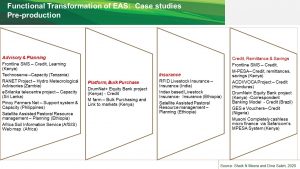
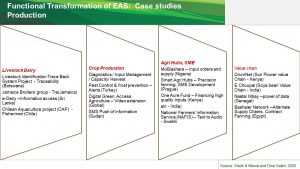
Based on a critical analysis of digital extension efforts before and after COVID, we can expect transformational changes in EAS organizations post the pandemic. We may witness increased use of digital tools in training and awareness, capacity building, input supply (e-marketing), machinery rental, financial inclusion (credit and insurance), weather information, prior market information, agri input directory, soil testing, information on government schemes, crop insurance, precision agriculture installations (drip, sprinkler), protective structures installation, drones for decision making, etc.
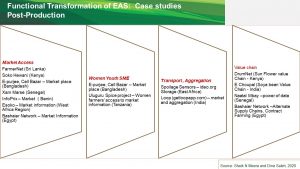
Much of what EAS organizations are doing may see radical changes in the use of advanced digital tools for linking farmers with experts (even to AI experts) for crop management advisories, AI based Crop and pest management advisories, farmers forum, smart devices for agriculture, real time training and skill development, digital apps, prediction services, contract farming, drones for application, seed chains, harvesting and post-harvest management, Uber models, adoption tracking / management, smart supply chain activities etc.,
EAS may have to respond to growing needs of farmers with the functional transformation in post-harvest management as well. The digital transformation could be seen in smart grading, packing, transportation, processing, cold storage, linkage of buyers and sellers, procuring produce from the farmers, direct to consumer models, aggregation, digital payments, traceability, smart storage, warehouse slips, e-vouchers, etc.,
ACCELERATING DIGITAL EXTENSION: BUNDLED AND BLENDED WITH PARTNERSHIPS
In future, EAS organizations have to identify the value proposition for every need of the farmer and try to bundle extension services with production inputs, financial inclusion with mobile money, machine rentals etc. Contrary to the fact that public extension has an advantage in terms of scale, reach and data, they also have limitations in terms of rigid workflows and inability to bring innovations abruptly. This necessitates forging partnerships with a range of stakeholders. For this we need to map functionalities for deployment in comprehensive digital extension ecosystem. As time passes, extension services (with both information and technology interventions) should bundle with personalized advisories and weather forecast models. If either of these services lag behind it would result in inappropriate and ineffective solution at farm level. For example, simple weather Forecast services can be enveloped with value added services by partnering with several stakeholder organizations as shown in the illustration.
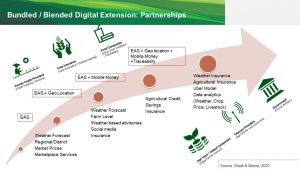
In the future, new digital partnership may evolve with the AgTech and Fintech agencies or start-ups for improving the impact of EAS. As per NASSCOM’s 2019 report, India is home to more than 450 agri-tech start-ups, growing at 25% annually. The sector has received more than $248 million in funding, which is a clear indication of the agri-tech industry’s growth potential. Given that the food economy impacts human population, there’s huge scope for building a seamless ecosystem in the agri-technology space.
The challenge to farmers is in the timely and adequate accessibility of finance, which is a prerequisite being addressed by a few start-ups. Most rural FinTech start-ups are developing innovative approaches to financing farmers and agricultural value chains, while others are creating technology-enabled solutions for insurance, savings, or commodity risk management. A few start-ups include Sammunati, GramCover, Kissht and Jai Kisan.
There is an interesting collaboration that was forged during COVID i.e., between the multi-national Bayer and a Pune-based e-commerce firm AgroStar to deliver its products like seeds and pesticides to farmers. Farmer get services such as seeds and crop protection products along with the knowledge intensive advisories. AgroStar is fulfilling farmers’ orders through its 500+ strong network of last mile delivery partners, who are doing doorstep delivery of agri-inputs while following hygiene and social distancing norms.
DIGITAL EXTENSION IS DYNAMIC AND DO WHATEVER IT TAKES
In several sectors it is not the well-established organizations but new entrants and entrepreneurs who are creating waves by meeting consumer needs in novel ways. The job charts of professionals are changing fast with strong digital skill sets. Their workstyles are different, ways of approaching a problem are different. If we are sceptical about this for agriculture, it’s probably because we have seen many digital projects before without much “wow” factor.
COVID type of crises give us an opportunity to redefine our approaches, particularly in harnessing of digital tools. Unlike other sectors, public EAS is relevant even when agricultural value chains are witnessing digital disruption. There is no better and opportune time than now to work on blended approaches and bundle extension services with new partnership models. To realise the digital disruption in public EAS we need to create avenues for redesigning extension processes (work on the frameworks not on the guidelines), stimulate new thinking (capturing innovations and start-ups within the system) and dynamic inclusion of crowd sourced extension innovations (allowing partnerships and local redesigning to certain extent).
EAS must acquire and implement digital tools for a truly modern, farmer-centric, retail-like operating model that integrates available and emerging digital technologies to meet and exceed expectations of agriculture sectoral needs.
Box 1. How to digitally disrupt EAS
Source: Shaik N Meera, 2018 |
Jason Furman, former US President Barack Obama’s Chief Economist, adds some guide rails to the ‘do whatever it takes’ idea. His advice, which I feel is relevant to current EAS response, comes in six points and I am modifying the same with a digital extension perspective:
- Better to do too much rather than too little: Explore comprehensive solutions for farmers without any boundary of structured mandates that we are programed with for last several decades. Do whatever that could be done with digital systems available with organizations.
- Use existing mechanisms as much as possible: We know that there is no single EAS agency that has not started using digital tools for disseminating information, technology and services to the farmers. However small the effort may be, keep exploring the use of digital tools innovatively.
- Invent new programmes where necessary: New challenges cannot be handled with older methodologies. As Shiv Khera says, winners don’t do different things, they do things differently. While handling newer challenges, keep inventing new extension programs and while doing so do not shy away from leaving the comfort zone.
- Diversify and do not fear duplication or the unexpected in the process: Remember how EAS organizations worked towards community development in rural areas during 1950s. The narrow restrictions of organizational mandates will hamper achievements in our own mandates. For example, if providing market information was thought of our job, if we do not work on aggregation, our impact of market information delivery will be limited. Reach out with a bouquet of solutions. I must say, majority of the KVKs do diversify thanks to individual champions answering the call of farmers.
- Engage the private sector as much as possible: Do not shy away from collaborating with the private sector. The technology edge that AgTech and FinTech companies and start-ups have, public and civil society organizations might not be have. Private players may be roped in (if not enlisted for a brief period during the disasters / emergency situation) for making concerted efforts on mission critical strategic extension interventions.
- Ensure that response is dynamic and persistent: Majority of EAS agencies do enjoy flexibility of operations towards achieving overall objectives of a programmes. Compared to organizations in other sectors, EAS do have adaptation capability and approval for adaptation exists. The responsiveness is more important than organizational workflows / approvals. It is easier said than done in organizations that have strict hierarchy in administration. But agencies such as KVKs and certain private agencies are more flexible in terms of approaching a problem. Once the dust settles, EAS organizations should continue to innovate to bring in scalable extension strategy.
CONCLUSIONS
In the past, the Extension Advisory Services (EAS) have helped countries move towards meeting food needs, conserving natural resources and developing human and social capital. However, the need for new extension functionalities and job charts are echoed all over the world. Especially, the small holder farmers need real time solutions and become connected to the service providers (even at affordable costs). The crisis situation such as COVID, can act as a tipping point for digital transformation of EAS organizations. As we have seen in the blog, the organizations that have responded well are those that are already having the digital systems in place, and tweaked them to suit to the exigencies and quick enough to collaborate with the other complimentary services.
For providing ‘what farmers want’ in faster, better and cost effective way, EAS organizations need to innovate continuously with the better functionalities. New extension functionalities (like data driven personalized services in credit, insurance, markets, inputs supplies, aggregation models, traceability etc.,) will transform the way EAS was carried out in the recent past. There are other aspects of digital transformation that should be simultaneously taken care such as building appropriate infrastructure with proper scales of economy, building relevant capacities of extension professionals, integrating the complex digital processes into the basic agricultural workflows (such as agricultural inputs / services / knowledge / value chain).
In future, EAS organizations have to identify the value proposition at every need of the farmer and try to bundle the extension services with production inputs, financial inclusion with mobile money, machine rentals etc., In future, new digital partnership may evolve with the AgTech and Fintech agencies or Start-ups for improving the impact of EAS. There is no better and opportune time than this to work on blended approaches and bundling extension services with new partnership models. Yes! COVID can truly be a tipping point for Transformational Changes with Digital Extension. If not now when? If not we, who?
References
Boteler, F. E. (2007). Building disaster-resilient families, communities, and businesses. Journal of Extension [On-line], 45(6). Article 6FEA1. Available at: http: https://www.joe.org/joe/2007december/a1.php
Cathey, L., Coreil, P., Schexnayder, M., & White, R. (2007). True colors shining through: Cooperative Extensions strengths in time of disaster. Journal of Extension [On-line], 45(6). Article 6COM1. Available at: https://www.joe.org/joe/2007december/comm1.php
Kevin Chen, Mark Leclair, Esmail Karamidehkordi, Carl Larsen, and Suresh Babu (2020). Extension and Advisory Services Role in the COVID-19 Crisis. Agrilinks. Accessed on 17 May 2020. https://www.agrilinks.org/post/extension-and-advisory-services-role-covid-19-crisis
Shaik N Meera (2020). Towards a Digital Extension Framework in Post COVID-19 Context: Functional Transformation of EAS Organizations. Keynote address in Accelerating Digital Extension Advisory Services Zoominar, IFAD, FAO. 14 May 2020. https://paepard.blogspot.com/2020/05/accelerating-digital-extension-advisory.html
Shaik N Meera (2020). Towards a Digital Extension Framework in Post COVID-19 Context: Functional Transformation of EAS Organizations. https://www.youtube.com/watch?v=hzKrj-dV-58
Shaik N Meera and Dina Saleh (2020). Unpublished Digital Extension Background Paper. International Fund for Agricultural Development (IFAD).
Shaik N Meera (2017). Disruptive Technologies – Big Data and Internet of Things in Strengthening Extension & Advisory Services. Agricultural Extension in South Asia. https://www.aesanetwork.org/disruptive-technologies-big-data-and-internet-of-things-in-strengthening-extension-advisory-services/
Shaik N Meera (2018). A Treatise on Navigating Extension and Advisory Services through Digital Disruption. Agricultural Extension for South Asia. Online blog. https://www.aesanetwork.org/a-treatise-on-navigating-extension-and-advisory-services-through-digital-disruption/
Spencer, K., (2011). Rural Assistance Center, Community Emergency Response Team. Retrieved from: http://www.raconline.org/info_guides/preparedness/faq.php#difference
 Shaik N Meera currently works for Indian Council of Agricultural Research as Principal Scientist and National Coordinator of Frontline Demonstrations in Rice. He has published several papers, books and blogs on Digital Extension. Views expressed are his and do not represent those of the organization he serves. Email: shaiknmeera@gmail.com
Shaik N Meera currently works for Indian Council of Agricultural Research as Principal Scientist and National Coordinator of Frontline Demonstrations in Rice. He has published several papers, books and blogs on Digital Extension. Views expressed are his and do not represent those of the organization he serves. Email: shaiknmeera@gmail.com

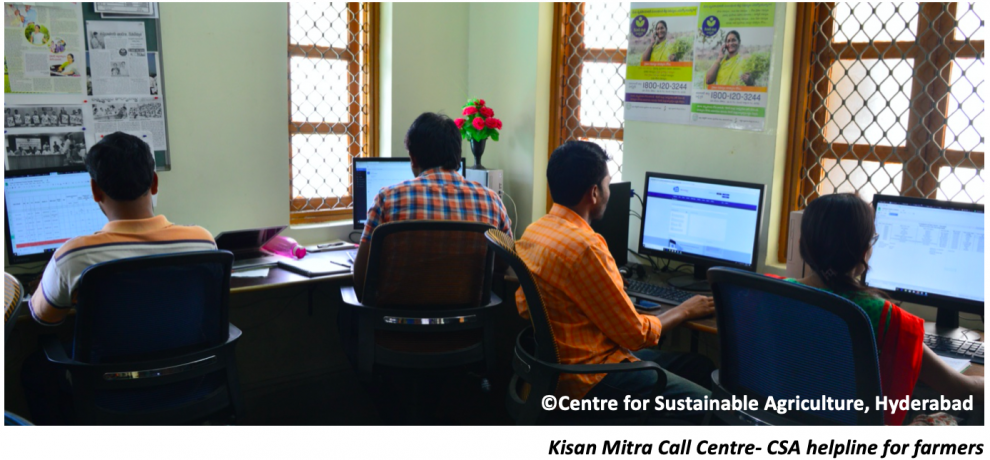
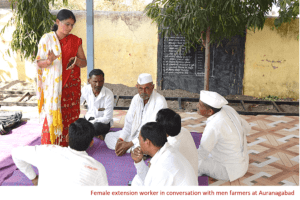
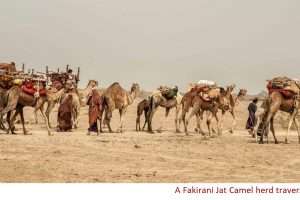
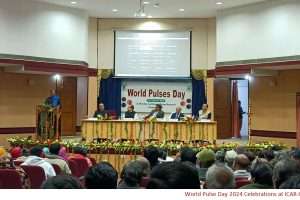
I would like to contact this author. Perhaps Kerala state of India will also be benefited.